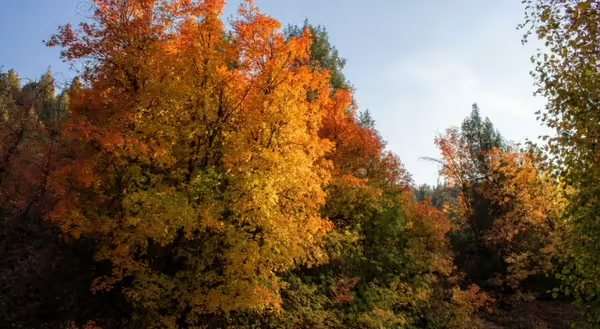
Fall is the season of change. With shades of red, yellow, orange, bronze, brown, and purple scattered through the landscape, Central Illinois becomes a beautifully painted scene.
Deciduous trees, those that lose their leaves every fall, create a stunning fall display as they prepare for winter temperatures. With daylight hours decreasing and the sun lower in the sky, the production of chlorophyll (green pigments) decreases in tree leaves revealing other colorful pigments in a showcase of autumnal hues.
Each year, the intensity of each specimen’s fall color varies based on the season’s weather and the vibrancy of fall colors varies among trees and shrubs. Consider these standout selections if you are seeking a deciduous plant for your fall display.
- Black gum (Nyssa sylvatica), or black tupelo, leaves turn from a glossy green to a brilliant scarlet in the fall. The fall color is enhanced in full-sun locations. With unique, deeply ridged bark and horizontal branching habit, black gum makes a great medium-sized specimen that grows thirty to fifty feet tall.
- Bald cypress (Taxodium distichum) often tricks people into thinking it is an evergreen tree with needled foliage. However, come fall, this pyramidal-shaped, deciduous conifer (cone-bearing plant) develops russet red foliage before dropping its leaves for the winter.
- Ginkgo trees (Ginkgo biloba) are unique and distinct specimens in a landscape. Its fan-shaped leaves densely covering the tree turn a vivid yellow color in the fall. All the leaves fall off the tree within a few days of the first hard frost as the leaf scars are all healed over for winter, creating a yellow blanket under the tree.
Large shade and ornamental trees are not the only ones on display this season; many shrubs rival the large trees with their fall color.
- Oakleaf hydrangea (Hydrangea quercifolia) offers a stunning and dramatic display in the garden year-round; large oak-like leaves and panicle white blooms of summer transform into a rainbow of red, purple, yellow, and orange leaves in fall alongside perfectly dried blooms which remain on the plant. Mature plants eight feet tall exhibit reddish-brown exfoliating bark.
- Chokeberry (Aronia melanocarpa) is a deciduous shrub that offers multi-season interest and many new cultivars for small spaces. Small, black berries are produced in late summer and persist on the plant into fall amongst the bright red to dark purple foliage.
- Virginia sweetspire (Itea virginica) is a great native alternative to the invasive burning bush, with its versatility, dependability, and stunning red, orange, and yellow fall color. Its spreading habit and arching branches make it a great plant for mass plantings and borders.
As the days remain cool and plants prepare for winter dormancy, take a drive under the canopy of color—too soon it will be swept away with the arrival of winter’s chill.
ABOUT THE AUTHOR: Brittnay Haag is a Horticulture Educator with University of Illinois Extension, serving Livingston, McLean, and Woodford Counties. Her work focuses on youth horticulture education, specifically through school gardens and Jr. Master Gardener programs. Brittnay provides leadership for three county Master Gardener programs and is responsible for developing community programs and providing expertise in horticulture and environmental sciences.